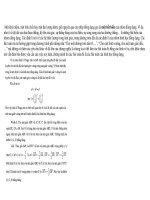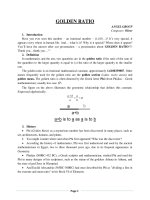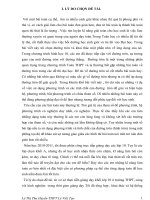Ứng dụng tỉ số vàng trong giải toán
Bạn đang xem bản rút gọn của tài liệu. Xem và tải ngay bản đầy đủ của tài liệu tại đây (797.85 KB, 7 trang )
Page 1
GOLDEN RATIO
ANGEL GROUP
Composer: Oliver
1. Introduction
Have you ever seen this number – an irrational number – (1,618…)? It’s very special, it
appears every where in human life. And… what is it? Why is it special? Where does it appear?
You’ll have the answer after our presentation – a presentation about GOLDEN RATIO!!!!
Thank you…thank you…^^
2. Definition
In mathematics and the arts, two quantities are in the golden ratio if the ratio of the sum of
the quantities to the larger quantity is equal to (=) the ratio of the larger quantity to the smaller
one.
The golden ratio is an irrational mathematical constant, approximately 1.6180339887. Other
names frequently used for the golden ratio are the golden section (Latin: sectio aurea) and
golden mean. The golden ratio is often denoted by the Greek letter Phi (from Phidias – Greek
mathematician), usually low case
.
The figure on the above illustrates the geometric relationship that defines this constant.
Expressed algebraically:
a b a
ab
3. History
Phi (Golden Ratio) as a mysterious number has been discovered in many places, such as
art, architectures, humans, and plants.
You might wonder where and when Phi first appeared? Who was the discoverer?
According the history of mathematics, Phi was first understood and used by the ancient
mathematicians in Egypt, two to three thousand years ago, due to its frequent appearance in
Geometry.
Phidias (500BC-432 BC), a Greek sculptor and mathematician, studied Phi and used the
Phi in many designs of his sculptures, such as the statue of the goddess Athena in Athena, and
the state of god Zeus in Olympiad.
And Euclid Alexandria (365BC-300BC) had once described the Phi as "dividing a line in
the extreme and mean ratio" in his Book VI of Elements.
Page 2
The name "Golden Ratio" appears in the form sectio aurea (Golden Section in Greek) by
Leonardo da Vinci (1452-1519) who used this the Golden ratio in many of his masterpieces, such
as The Last Supper and Mona Lisa.
In 1900s, an Maerican mathematician named Mark Barr, represented the Golden Ratio by
using a greek symbol Φ.
4. Golden ratio in maths
The first, can you find the positive solution of this equation?
2
10xx
, and you can
only get one, that is
15
1,618
2
The value of continued fraction:
1
1 1,618
1
1
1
1
1
1
1
Exact trigonometric formulas for
include:
2cos( ) 1,618
5
A representation in terms of a nested radical is:
1 1 1 1 1 1,618
This
is equivalent to the recurrence equation:
2
1
1
nn
aa
with
1
1a
and
lim
n
n
a
The Fibonacci Sequence is an infinite sequence, which means it goes on for ever, and as
it develops, the ratio of the consecutive terms converges (becomes closer) to the Golden Ratio,
~1.618. For example, to find the ratio of any two successive numbers, take the latter number and
divide by the former. So, we will have:
1
1
1
2
2
1
3
1,5
2
55
1,618
34
The golden ratio also appears in comparing consecutive elements of certain kinds of
sequences, most notably, the Fibonacci sequence, but other sequences also. For instance, take
two numbers at random, say 2 and 6. Add them to get 8. Add 6 and 8 to get 14. Add 8 and 14 to
get 22. If you keep this going indefinitely, then the ratio of successive numbers approaches the
golden ratio as a limit. Hence, for starters:
Page 3
2 6 8 (8/ 6 1,33 )
6 8 14 (14 /8 1,75)
8 14 22 (22 /14 1,57 )
58 94 152 (152 / 94 1,617 1,618 )
The Golden Rectangle can be subdivided into squares and additional smaller Golden
Rectangles, again a process that seemingly could go on indefinitely. In the figure below the
figures 1, 2, 3, 4, and 5 are all squares. In each square a quarter circle can be drawn in such a
way that a spiral is created
The Gold parallelogram has golden ratio, you can recognize it by finding the ratio of
longer side to the shorter side.
Page 4
5. The golden ratio exists on everywhere in our life
The golden ratio number on Parthenon (Athens - Greece)
The ratio of temple’s length to temple’s height and others… is approximately 1.618
Monalisa (a Da Vinci’s masterpiece)
Mona Lisa's face is a perfect golden rectangle, according to the ratio of the width of her
forehead compared to the length from the top of her head to her chin.
Page 5
In the Status of Athena (the goddess of wisdom in Greek mythology)
Tthe first Golden Ratio is the length from the front head to the ear opening compared with the
length from the forehead to the chin. The second one appears in the ratio of the length from the
nostril to the earlobe compare with the length from the nostril to the chin.
The masterpiece "Last Supper" (another masterpiece of Da Vinci)
It contains a golden ratio in several places, appearing in both the ceiling and the position where
the people sit.
Page 6
Notation of Phi
The golden ratio on plant…
And… snail
Page 7
e
On your body
THE END!









